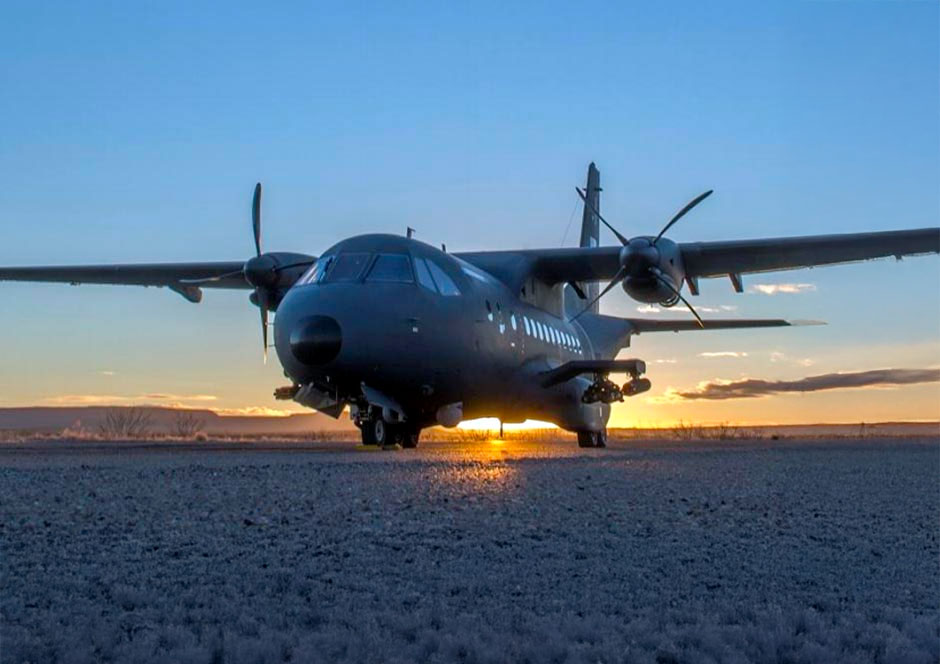The Orbital ATK AC-235 is a light gunship aircraft developed from the CN-235 platform, equipped for close air support and surveillance missions.
The Orbital ATK AC-235 is a light gunship derived from the CN-235 transport aircraft, designed for close air support (CAS) and intelligence, surveillance, and reconnaissance (ISR) missions. It features a high-wing configuration with twin turboprop engines, each producing 1,750 shaft horsepower. The aircraft is armed with a 30mm M230LF autocannon, capable of side-firing, and can carry AGM-114 Hellfire missiles and 70mm rocket pods on fuselage-mounted pylons. Its avionics suite includes an electro-optical/infrared (EO/IR) sensor with laser designator, synthetic aperture radar, and integrated fire control systems. The AC-235 is equipped with defensive countermeasures, including the AAR-47/ALE-47 systems and ballistic protection for the cockpit and crew areas. Developed jointly by Orbital ATK and Jordan’s King Abdullah II Design and Development Bureau (KADDB), the AC-235 enhances operational capabilities in asymmetric warfare environments.
The Orbital ATK AC-235 is a light gunship aircraft developed to provide enhanced close air support and ISR capabilities, particularly suited for counterinsurgency and border security operations. Based on the CN-235 transport platform, the AC-235 integrates advanced weaponry and sensor systems to deliver precise firepower and real-time intelligence in various operational scenarios. Its development reflects a growing need for versatile and cost-effective aerial platforms capable of addressing modern asymmetric threats.
History of Development
In the early 2010s, the global security landscape was increasingly characterized by asymmetric warfare, with non-state actors and insurgent groups posing significant challenges to conventional military forces. Traditional heavy gunships, such as the AC-130, while highly effective, were costly to operate and maintain. This context created a demand for more affordable, versatile, and rapidly deployable light gunship platforms capable of providing close air support and ISR capabilities in counterinsurgency operations.
Recognizing this need, Orbital ATK, an aerospace and defense company formed in 2015 through the merger of Orbital Sciences Corporation and Alliant Techsystems, collaborated with the King Abdullah II Design and Development Bureau (KADDB) of Jordan to develop a light gunship variant of the CN-235 transport aircraft. The objective was to create a platform that could deliver precise firepower, conduct surveillance, and operate in austere environments with lower operational costs compared to heavier gunships.
The program commenced in February 2011, focusing on converting the CN-235 into a multi-mission gunship. The CN-235, originally developed by CASA (now part of Airbus Military), was chosen for its proven reliability, short takeoff and landing capabilities, and adaptability to various mission profiles. The modification process involved integrating advanced weapon systems, sensors, and defensive countermeasures into the existing airframe.
The first AC-235 prototype completed its maiden flight in early 2014, followed by a series of rigorous testing phases to validate its performance and systems integration. The aircraft was officially unveiled to the public during the Special Operations Forces Exhibition (SOFEX) held in Amman, Jordan, from May 6 to 8, 2014. This event marked the introduction of the AC-235 as a viable solution for nations seeking cost-effective and versatile light gunship capabilities.
The AC-235 does not have a specific NATO reporting name, as it is a relatively recent development and primarily operated by Jordan. Its design philosophy emphasizes modularity and adaptability, allowing for future upgrades and customization based on specific operational requirements. The collaboration between Orbital ATK and KADDB exemplifies a successful partnership aimed at enhancing regional security through indigenous defense capabilities.
In summary, the development of the AC-235 was driven by the evolving nature of global conflicts, necessitating agile and cost-effective aerial platforms capable of delivering precise firepower and real-time intelligence. The joint efforts of Orbital ATK and KADDB resulted in an aircraft that addresses these needs, providing operators with a versatile tool for modern warfare scenarios.

Design of the Orbital ATK AC-235
The Orbital ATK AC-235 is a light gunship aircraft developed from the CN-235 platform, designed to provide close air support and intelligence, surveillance, and reconnaissance capabilities. The aircraft features a high-wing configuration with twin-engine turboprops, each producing 1,750 shaft horsepower. It is equipped with a 30mm M230LF autocannon mounted on the side, capable of engaging ground targets with precision. Additionally, the AC-235 can carry AGM-114 Hellfire missiles and 70mm rocket pods on fuselage-mounted pylons, enhancing its strike capabilities. The avionics suite includes an electro-optical/infrared sensor with laser designator, synthetic aperture radar, and integrated fire control systems, enabling effective target acquisition and engagement. Defensive countermeasures, such as the AAR-47/ALE-47 systems, and ballistic protection for the cockpit and crew areas are incorporated to enhance survivability in hostile environments. The AC-235’s design emphasizes versatility and adaptability, making it suitable for various mission profiles in modern asymmetric warfare scenarios.
Performance of the Orbital ATK AC-235
The Orbital ATK AC-235 is powered by two General Electric CT7-9C3 turboprop engines, each delivering 1,750 shaft horsepower. This propulsion system enables the aircraft to achieve a maximum speed of approximately 250 knots (463 km/h) and a service ceiling of 25,000 feet (7,620 meters). The AC-235 has a range of around 2,300 nautical miles (4,260 kilometers), allowing for extended mission endurance. Its short takeoff and landing capabilities enable operations from austere airstrips, enhancing its operational flexibility. When compared to similar platforms, the AC-235 offers a balanced combination of speed, range , and payload capacity. While it is not as fast or heavily armed as larger gunships like the Lockheed AC-130, it compensates with lower operational costs, greater maneuverability, and the ability to operate in more constrained environments.
The 30mm M230LF autocannon is a key feature of the AC-235, allowing for accurate engagement of ground targets. Its side-firing configuration enables the aircraft to perform effective close air support (CAS) missions. The addition of AGM-114 Hellfire missiles and 70mm rocket pods extends its strike capabilities, making it suitable for engaging a variety of threats, from armored vehicles to personnel.
The avionics suite, which includes an EO/IR sensor with a laser designator and synthetic aperture radar (SAR), provides the AC-235 with advanced target acquisition and tracking capabilities. The integration of these systems ensures precise strikes and enhances situational awareness. Defensive features such as the AAR-47/ALE-47 systems and ballistic protection for critical areas improve survivability in contested environments.
Overall, the AC-235’s performance makes it a cost-effective option for nations requiring a versatile gunship for counterinsurgency, border patrol, and reconnaissance missions. While it may not rival the firepower of larger aircraft, its adaptability and efficiency ensure it remains a valuable asset in modern asymmetric warfare scenarios.
Variants of the Orbital ATK AC-235
The AC-235 primarily exists in its standard configuration, developed jointly by Orbital ATK and the King Abdullah II Design and Development Bureau (KADDB). This version is equipped with a combination of a 30mm autocannon, AGM-114 Hellfire missiles, and 70mm rocket pods, alongside advanced ISR systems.
A variant under consideration includes upgraded avionics and additional sensors, potentially integrating enhanced SIGINT (Signals Intelligence) capabilities for broader mission profiles. These upgrades are intended to increase the aircraft’s utility in electronic warfare and intelligence-gathering operations.
Although the AC-235 has not seen widespread adoption outside Jordan, its modular design allows for future customization and upgrades based on specific operational requirements. This flexibility ensures that operators can tailor the aircraft to meet evolving mission demands.

Military Use and Combat of the Orbital ATK AC-235
The AC-235 has been deployed primarily by the Jordanian Air Force for counterinsurgency, border security, and ISR missions. Its versatility and precision strike capabilities make it well-suited for asymmetric warfare, where rapid response and adaptability are critical.
One of the AC-235’s notable roles is border patrol operations, where it conducts surveillance along Jordan’s borders to monitor and deter illegal crossings, smuggling, and militant activity. The combination of EO/IR sensors and radar allows it to track ground movements effectively, providing real-time intelligence to ground forces.
The aircraft has also been employed in counterinsurgency missions against non-state actors operating in the region. In these operations, the AC-235 has delivered precise airstrikes using its 30mm autocannon and Hellfire missiles, effectively neutralizing threats while minimizing collateral damage. For example, during joint military exercises with allied forces, the AC-235 demonstrated its ability to engage targets in rugged terrain, showcasing its operational flexibility.
The AC-235 is equipped with defensive systems, such as the AAR-47 missile warning system and ALE-47 countermeasures dispenser, which enhance its survivability in contested airspace. These systems detect and counter incoming threats, ensuring the safety of the aircraft and its crew.
While the AC-235 has not been sold to a wide range of international customers, its cost-effectiveness and adaptability make it an attractive option for nations with limited defense budgets. Discussions about potential exports have highlighted the aircraft’s value as a multi-role platform capable of addressing various security challenges.
Despite its capabilities, the AC-235 is not intended to replace larger gunships like the AC-130. Instead, it complements them by offering a more affordable solution for specific mission types. As of 2025, the AC-235 remains in active service with the Jordanian Air Force, with ongoing evaluations for upgrades to enhance its operational capabilities further.
The Orbital ATK AC-235 represents a practical solution for nations requiring a versatile, cost-effective platform for close air support and ISR missions. Its combination of precision weaponry, advanced sensors, and defensive systems ensures its effectiveness in asymmetric warfare and border security operations. While it lacks the heavy firepower of larger gunships, its adaptability, lower operational costs, and ability to operate in austere conditions make it a valuable asset for modern militaries. The AC-235’s modular design and potential for future upgrades ensure its continued relevance in evolving combat scenarios.
Back to the Special Aircraft section